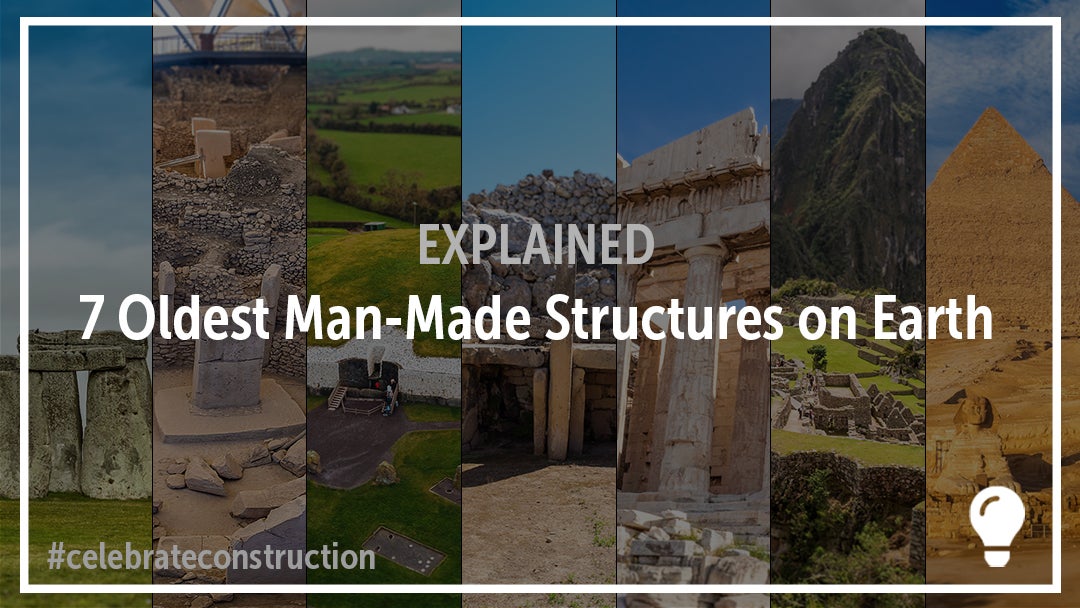
Discover 7 of the Oldest, Man-Made Structures on Earth
Good, old humankind has been building structures for thousands of years. From simple huts and shelters for hunter-gatherers to the huge dams and skyscrapers of modern day, we’ve left a mark on this world in every place we’ve been. And while the age of a structure isn’t the only thing worth noting about a site, knowing a building or place has stood the test of time, weathered the elements, and escaped the ebb and flow of history for thousands of years is something to respect and admire (we think).
To celebrate the history of construction, we’ve put together this short list of some of the oldest still-standing structures on Earth.
What Are the Oldest, Man-Made, Still-Standing Structures on Earth?

Göbekli Tepe
Built between 9500 and 8000 BCE and located in the Southeastern Anatolia Region of Turkey, Göbekli Tepe is composed of a series of circular stone enclosures and massive stone pillars. The site is built on a tell (artificial mound) and though many believe the site had religious purposes others think it was designed as a meeting place for hunters and gathers.
The pillars from which Göbekli Tepe were built are made of limestone and were quarried from nearby mountains. The pillars weigh up to 10 tons and their building and positioning predates the development of the wheel by thousands of years.

The Megalithic Temples of Malta
Dating back to between 3600 and 2500 BC, the Megalithic Temples of Malta are a group of prehistoric, free-standing structures located on the islands of Malta and Gozo. Some archaeologists believe the structures were used as temples, while others believe they were used as tombs, and some suggest the sites were used for both religious and funerary purposes.
The temples were built by the Maltese, skilled stonesman who used large blocks of limestone and wooden pegs to construct the structures. Many of the temples feature corbel arches, an arch built by gradually inching overlapping stones as the arch grows in height until they meet in the center and complete the arch.
The large limestone blocks were transported from nearby quarries using rollers, sledges, and wooden levers and all of the structures were built completely without the use of metal tools.

Newgrange
Built around 3200 BC, Newgrange is a prehistoric monument located in the Boyne Valley in Ireland. The structure consists of a large circular mound with an inner stone passageway that leads to an inner chamber. While the covering mound is made from dirt and stones, the entire structure was constructed using white quartz, limestone, and wood.
It is estimated building Newgrange took over 20 years and required the work of over 1000 people, including skilled engineers and builders of the day. Notably, the structure is aligned with the winter solstice in such a way that on the morning of the solstice a beam of sunlight shines through a small opening in the roof and illuminates the inner chamber.

Stonehenge
Built in several stages from around 3000 to 2000 BC, Stonehenge is a prehistoric stone circle in Wiltshire, England. In its original form Stonehenge consisted of a number of wood and stone circles with the largest, still-standing outer stones creating a circle with a diameter of 108 feet and a height of 33 feet.
The structure is aligned with the summer solstice in such a way that on the longest day of the year the sun rises directly overhead of the stone at the structure’s center, the Heel Stone. The stones themselves, weighing from 5 tons to 30 tons, are believed to have been brought to the site from the Preseli Hills in Wales, about 150 miles away.

The Great Pyramid of Giza
Built around 2560 BC, the Great Pyramid of Giza in Egypt is a massive structure with a base that measures over 756 feet on each side and with a height of 481 feet. The pyramid includes a number of inner chambers and passages. At the center is the King’s Chamber, a large rectangular room lined with granite blocks with the ceiling made of one single granite block estimated to weigh over 25 tons.
The pyramid is aligned with the 4 points of the compass. It is estimated the pyramid’s construction involved over 100,000 workers who cut, shaped, and placed the approximately 2.3M limestone blocks, each weighing between 2.5 to 15 tons.

The Parthenon
Constructed from 447 BC to 438 BC, the Parthenon on the Athenian Acropolis in Greece is a Doric temple that consists of large, simple stone columns with triangular gables at the front and the back of the building. The building is a former temple dedicated to the goddess Athena, whom the people of Athens considered their patron.
The Parthenon is built from white marble, which was quarried from Mount Pentelikon, which is located about 10 miles from Athens and was transported by oxcart and eventually by hand to the site. The Parthenon’s pillars weigh about 20 tons each and are around 32 feet tall.

Machu Picchu
Built around 1450 AD, Machu Picchu is a sprawling ancient Inca sanctuary built on a mountain ridge in southern Peru. Many archaeologists believe Machu Picchu was built as a retreat and royal estate for an Incan ruler after a successful military campaign as the remote location would have provided the emperor space to relax and escape.
Three primary structures define Machu Picchu and much of the current structure has been rebuilt to provide visitors with a better sense of the original. Built with polished dry-stone walls, Machu Picchu highlights the design skills of the Incas, while the accompanying Sacred Valley below illustrates their agricultural and irrigation skills.
Hopefully, you found this list as interesting to read as we did to put together. As part of our Celebrate Construction series, we like to remind ourselves that Team Build isn’t just big, it’s been around for a long time, too. If you’ve arrived here in search of parts, we’re always here to help, whether you’re working on something that’s intended to last a week or you’re hoping it’ll last for generations.



